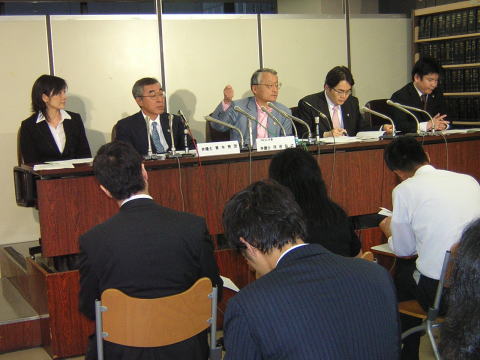|
||||
|
||||
| 怽棫偺攚宨 丂柧帯埲崀丄擔杮惌晎偼堏柉傪惙傫偵姪傔丄僼傿儕僺儞偵偼枮廈偵師偄偱懡偔偺乮3枩恖傪挻偊傞乯擔杮恖堏柉偑偄傑偟偨丅偆偪2枩恖偼傾僶僇(僼傿儕僺儞杻)偺惗嶻傪惗嬈偲偟偰丄僟僶僆廃曈偵朙偐側擔杮恖幮夛傪偮偔偭偰偍傝丄懡偔偼僼傿儕僺儞恖偲寢崶偟壠懓傪傕偆偗丄尰抧幮夛偵偲偗崬傫偱惗妶偟偰偄傑偟偨丅偟偐偟丄戞擇師悽奅戝愴偺杣敪偵傛傝丄嵼斾擔杮恖偼擔杮孯傊偺嫤椡傪梋媀側偔偝傟丄傾儊儕僇孯傗僼傿儕僺儞僎儕儔傪揋偵傑傢偡偙偲偵側傝傑偟偨丅擔杮孯偼栺2擭娫僼傿儕僺儞傪愯椞偡傞傕丄傗偑偰愴嬊偑孹偒攕憱偵捛偄崬傑傟傑偟偨丅崿棎偺拞丄斵傜傕孯偲峴摦傪嫟偵偟丄愴巰偡傞偐丄曔椄廂梕強峴偒偲側偭偨幰偼屻偵擔杮傊嫮惂憲娨偝傟偨偺偱偡丅偙偆偟偰擔杮恖偺寣傪傂偔巕偳傕払偑僼傿儕僺儞偵巆偝傟傞偙偲偵側傝傑偟偨丅愴屻斵傜偼丄擔杮孯偺巆媠峴堊偺曬暅偺懳徾偲側偭偨偨傔丄擔杮恖偺寣傪傂偔偙偲傪塀偟丄徹嫆傕幪偰偰曢傜偡偟偐偁傝傑偣傫偱偟偨丅偦偺懡偔偑丄枮懌側嫵堢傪庴偗傜傟偢丄嬯偟偄惗妶傪嫮偄傜傟傑偟偨丅 丂嬤擭偵側偭偰丄僶儔僶儔偵側偭偰偄偨擔宯恖傪慻怐偡傞摦偒偑峀偑傝丄僼傿儕僺儞奺抧偱擔宯恖夛偑愝棫偝傟傑偟偨丅擔宯恖偲偟偰偺嫟捠偺壽戣偲偟偰丄傾僀僨儞僥傿僥傿夞暅偺梫媮偑崅傑偭偰偄偒傑偟偨丅暯惉17擭偐傜偼丄俶俹俷朄恖僼傿儕僺儞擔宯恖儕乕僈儖僒億乕僩僙儞僞乕偺巟墖傪摼丄枹偩恎尦偑敾柧偟偰偄側偄2悽偨偪偑丄擔杮恖偲偟偰偺徹偟傪媮傔偰師乆偲廇愋怽棫傪峴偭偰偄傑偡丅 仏 廇愋丒丒丒屗愋朄110忦偺婯掕偵婎偯偒丄杮愋傪桳偟側偄擔杮恖偑丄壠掚嵸敾強偺嫋壜傪摼偰屗愋傪憂傞偙偲丅壠掚嵸敾強偑彂椶傪怰嵏偟丄怰敾傪壓偡丅 崙愋偵偮偄偰 丂怽棫恖偑惗傑傟偨摉帪巤峴偝傟偰偄偨崙愋朄乮柧帯32擭3寧16擔朄棩戞66崋乽媽崙愋朄乿乯偵偼丄乽巕僴弌惗僲帪懘晝僇擔杮恖僫儖僩僉僴擵儝擔杮恖僩僗乿乮戞1忦乯偲偄偆婯掕偑偁傝傑偡丅僼傿儕僺儞巆棷擔杮恖2悽傜偼丄擔杮恖偺晝偺巕偱偁傞偨傔丄朄棩揑偵偼擔杮崙愋傪帩偪傑偡丅乮偨偩偟丄朄棩忋偺晝巕娭學偑惗偠偰偄傞偐偳偆偐傪妋擣偡傞偨傔丄椉恊偑寢崶偟偰偄傞徹嫆偑偁傞偐偳偆偐傕怰嵏偝傟傑偡丅乯偟偐偟丄挿偔擔杮恖偱偁傞偙偲傪塀偟僼傿儕僺儞恖偲偟偰惗妶偟偰偒偨偨傔丄晝恊偲偺恎暘娭學傪徹柧偡傞傕偺偑彮側偔丄崱傑偱丄擔杮崙愋傪妋擣偡傞偙偲偑偱偒傑偣傫偱偟偨丅 崱夞偺怰敾偺堄媊 丂僼傿儕僺儞偵偼丄傢偐偭偰偄傞偩偗偱栺2500恖偺巆棷擔杮恖乮2悽乯偑懚嵼偟偰偄傑偡丅僼傿儕僺儞擔宯恖儕乕僈儖僒億乕僩僙儞僞乕偑峴偆挷嵏偵傛傝丄恎尦偑敾柧偡傞幰傕憹偊偰偼偄傑偡偑丄徹嫆彂椶傗徹尵偑偁傞偵傕偐偐傢傜偢恎尦偑敾柧偟側偄曽偑栺800恖巆偭偰偄傑偡丅崱夞偺怰敾偼丄偙偺巆偝傟偨曽乆偺媬嵪傊丄戝偒偔摴傪奐偄偨夋婜揑側寛掕偲偄偊傑偡丅崙愋妋擣傪朷傓屄乆偺僼傿儕僺儞擔宯恖偍傛傃擔宯恖幮夛偵丄戝偒側婓朷傪梌偊傞怰敾偲側傝傑偟偨丅 朄棩忋偺摿挜偼丄嘆抶墑搊榐傗嶶堩偟偨婰榐偵棟夝傪帵偟丄怣梡偱偒傞偲擣掕偟偨偙偲丄嘇擔杮恖彈惈偑僼傿儕僺儞抝惈偲崶堶偟偰傕僼傿儕僺儞偵婣壔偟側偄尷傝丄擔杮崙愋傪幐傢側偄偲偟偨偙偲丄嘊堜庤抂働乕僗乮晝偺廳崶働乕僗乯偲堘偄丄堦斒惈丒斈梡惈偑偁傞怰敾偱偁傞偙偲偱偡丅 |
||||
| Background of Shuseki* Petition Since the Meiji Restoration of 1867, the Japanese government had encouraged its citizens to migrate overseas, which resulted in over 30,000 Japanese migrants in the Philippines before WWII, the second largest group after the one in Manchuria. Among those residing in the Philippines, about 20,000 engaged in producing abaca (Manila hemp), which led to wealthy migrant society in the Davao area. In fact many Japanese men were married with Filipino women and raised families, adopting themselves to Philippine local communities. However, at the breakout of WWII, the Japanese migrants were forced to cooperate with Japanese Military乫s war efforts, which turned the U.S. Army and Philippine guerrillas against Japanese nationals. After its two-year occupation of the Philippines, Japan was beginning to lose the war. In the war-triggered turmoil, Japanese migrants working for the Japanese Military were killed or taken as hostages, who were repatriated to Japan after the war. On the other hand, most children of those Japanese migrants were left behind, mostly with their Filipino mothers, in the country. Because they became retaliatory targets of Japanese atrocities during the war, they hid their Japanese bloodline and discarded the documents and pictures indicating their Japanese origin. Consequently many were unable to have proper education and had to lead severe lives. In the 1980s, the movement to organize Japanese descendents who lived scatteringly throughout the Philippines was staged and a number of Nikkei-jin** groups were established across the country. The common challenge for the Nikkei-jin was to recover their identity. Since 2005, the Philippine Nikkei-jin Legal Support Center (PNLSC) has provided assistance by the legal method of Shuseki to second generation Nikkei-jin whose father乫s family registry has not been found. *Shuseki-: Based on Article 110 of the Family Registration Law, Japanese national who does not posses family register can file a petition with a family court in order to get permission to create a new family registry (Koseki). ** Nikkei-jin: A Japanese term for Japanese emigrants and their descendants who have established families and communities in recipient countries. The Issue of Nationality A nationality law (乬Old Nationality Law乭 No.66, March 16, 1899) has the regulation stating that 乬A child of a Japanese father shall become a Japanese citizen乭 (Article 1). Thus the 2nd generation who were left behind in the Philippines are entitled to have Japanese nationalities on the condition that their father-child relationship was lawful and proved by evidences. Nonetheless, many of them hid their Japanese identity and passed as Filipinos after WWII, and only a few evidences were found as a result, being unable to confirm their Japanese nationalities. The Importance of this Decision Approximately 2,500 Japanese descendants (second generation) have survived in the Philippines. Although the PNLSC乫s investigation has led to increasing the number of those who located their fathers乫 family registry, 800 or so Nikkei-jin have not been yet identified as Japanese despite their evidences. The decision by the Tokyo Family Court was an unprecedented one and will be encouraging news to Philippine Nikkei-jin who are still seeking their Japanese identity and Nikkei-jin society in the Philippines. |
||||
| 乻偙偺審偵娭偡傞栤崌傢偣愭乼丂 摿掕旕塩棙妶摦朄恖丂僼傿儕僺儞擔宯恖儕乕僈儖僒億乕僩僙儞僞乕乮俹俶俴俽俠乯 仹160-0004丂怴廻嬫巐扟1-21丂屗揷價儖4奒 Tel 03-3355-8861 Fax 03-3355-8862丂 E-mail info@pnlsc.com 丂HP http://www.pnlsc.com |
||||
